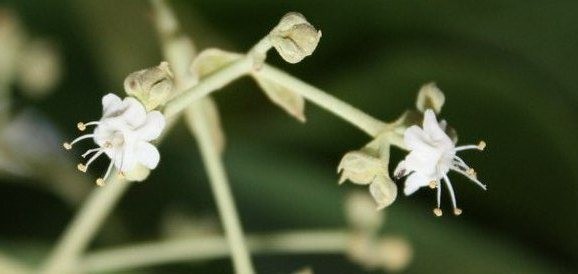Teak
(Tectona grandis)

Description
Teak (Tectona grandis) is a tropical hardwood tree species in the family Lamiaceae. It is a large, deciduous tree that occurs in mixed hardwood forests. Tectona grandis has small, fragrant white flowers arranged in dense clusters (panicles) at the end of the branches. These flowers contain both types of reproductive organs (perfect flowers). The large, papery leaves of teak trees are often hairy on the lower surface. Teak wood has a leather-like smell when it is freshly milled and is particularly valued for its durability and water resistance. The wood is used for boat building, exterior construction, veneer, furniture, carving, turnings, and other small wood projects. Tectona grandis is native to south and southeast Asia, mainly Bangladesh, India, Indonesia, Malaysia, Myanmar, Thailand and Sri Lanka, but is naturalised and cultivated in many countries in Africa and the Caribbean. Myanmar's teak forests account for nearly half of the world's naturally occurring teak. Molecular studies show that there are two centres of genetic origin of teak: one in India and the other in Myanmar and Laos. Teak is a large deciduous tree up to 40 m (131 ft) tall with grey to greyish-brown branches, known for its high quality wood. Its leaves are ovate-elliptic to ovate, 15–45 cm (5.9–17.7 in) long by 8–23 cm (3.1–9.1 in) wide, and are held on robust petioles which are 2–4 cm (0.8–1.6 in) long. Leaf margins are entire. Fragrant white flowers are borne on 25–40 cm (10–16 in) long by 30 cm (12 in) wide panicles from June to August. The corolla tube is 2.5–3 mm long with 2 mm wide obtuse lobes. Tectona grandis sets fruit from September to December; fruits are globose and 1.2–1.8 cm in diameter. Flowers are weakly protandrous in that the anthers precede the stigma in maturity and pollen is shed within a few hours of the flower opening. The flowers are primarily entomophilous (insect pollinated), but can occasionally be anemophilous (wind pollinated). A 1996 study found that in its native range in Thailand, the major pollinator were species in the bee genus Ceratina. Tectona grandis is one of three species in the genus Tectona. The other two species, T. hamiltoniana and T. philippinensis, are endemics with relatively small native distributions in Myanmar and the Philippines, respectively. Tectona grandis is native to India, Sri Lanka, Indonesia, Myanmar, northern Thailand, and northwestern Laos.
Taxonomic tree:







